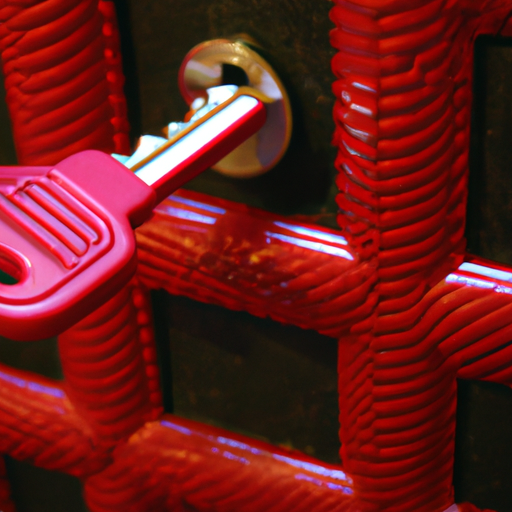Imagine a home where curious little hands can explore without the worry of danger, and where parents can relax with the peace of mind that their child is safe and protected. In today’s article, we will explore the importance of childproofing your home and how integrating both safety and security measures can create a secure environment for your little one. From securing fragile items to installing childproof locks, we will guide you through the essential steps to ensure your home is a haven of safety for your child. So, let’s get started on this journey of creating a child-friendly and secure living space together!
1. Assessing Potential Hazards
Identify common household hazards
Before childproofing your home, it is important to identify the common household hazards that may pose a risk to your child’s safety. These hazards can include sharp objects, open electrical outlets, slippery floors, and unsecured furniture.
Inspect the different rooms of your house
Take the time to thoroughly inspect each room of your house, paying close attention to areas where potential hazards might exist. Look for any items that could be easily accessed by your child and consider how you can modify these areas to make them safer.
Consider age-appropriate risks
When childproofing your home, it is important to take into account the age and developmental stage of your child. Different age groups have different risks, and understanding these risks can help you create a child-safe environment that meets their specific needs.
Evaluate potential choking hazards
Choking is a common hazard for young children, so it is important to evaluate your home for potential choking hazards. This can include small objects, loose change, and even certain types of foods. Be sure to keep small items out of reach and supervise your child closely during meal times.
Assess the availability of cleaning chemicals and medicines
Cleaning chemicals and medicines can be extremely hazardous if ingested by a child. Take the time to assess where these items are stored in your home and make sure they are out of reach or secured with childproof locks. Consider using child-resistant packaging for cleaning products and medications as an additional safety measure.
2. Creating a Child-Safe Environment
Install safety gates
Safety gates are an essential tool for creating a child-safe environment. They can be used to block off areas of your home that may pose a risk to your child, such as stairways or rooms with potential hazards. Make sure to choose gates that are sturdy and properly installed to ensure maximum safety.
Secure heavy furniture and TVs
Heavy furniture and TVs can be a tipping hazard for young children. Secure these items to the wall using brackets or furniture straps to prevent them from falling over. Ensure that any cords or wires are also out of reach or properly covered to prevent accidental strangulation.
Cover electrical outlets and cords
Electrical outlets and cords can be a source of danger for curious children. Use outlet covers to prevent your child from sticking their fingers or objects into the sockets. Additionally, use cord covers or cord organizers to keep cords out of reach and reduce the risk of tripping or pulling on them.
Secure window blind cords
Window blind cords can pose a strangulation hazard for young children. Use cord winders or cord cleats to secure the cords out of reach. Alternatively, consider installing cordless window blinds for added safety.
Use door stoppers and finger pinch guards
Doors can be a source of injury for small fingers. Install door stoppers to prevent doors from slamming shut and finger pinch guards to protect your child’s fingers from getting caught in doors. These simple additions can greatly reduce the risk of accidents.
Install cabinet and drawer locks
Cabinets and drawers can contain potentially hazardous items such as cleaning supplies or sharp objects. Install childproof locks or latches on cabinets and drawers to prevent your child from accessing these items. Ensure that all toxic substances are stored securely out of reach.
Eliminate or secure small objects
Small objects can be choking hazards for young children. Take the time to eliminate any small objects that could be easily swallowed or inhaled. If there are small objects that cannot be removed, make sure they are secured in a drawer or container that is out of reach.
Ensure a safe bath and shower area
Bathrooms can be dangerous for young children, especially when it comes to water-related accidents. Use non-slip mats in the bathtub or shower to prevent slips and falls. Keep all bathroom products, such as soaps and shampoos, out of reach and ensure that the water temperature is set to a safe level.
Use window guards and safety netting
If you live in a multi-story home, it is important to install window guards to prevent falls. Additionally, consider using safety netting on balconies or decks to provide an extra layer of protection.
Consider the placement of plants and decorations
Some plants and decorations can be toxic if ingested by young children. Ensure that any potentially toxic plants are kept out of reach or replaced with child-safe alternatives. Similarly, be mindful of the placement of decorations to prevent them from being easily pulled down or knocked over.
3. Childproofing Fire and Carbon Monoxide Hazards
Install smoke detectors
Smoke detectors are an essential safety feature in any home. Install them on every level of your house, including inside and outside of bedrooms. Regularly test the batteries and replace them as needed to ensure the detectors are in working condition.
Place fire extinguishers strategically
Having fire extinguishers readily available in your home can help you quickly respond to a fire emergency. Place them in high-risk areas such as the kitchen and ensure that everyone in the family knows how to use them properly.
Create a fire escape plan
In the event of a fire, it is crucial to have a well-practiced fire escape plan in place. Teach your child how to safely exit the house in case of an emergency, and designate a meeting point outside the home where everyone can gather.
Install carbon monoxide detectors
Carbon monoxide is a silent and odorless gas that can be deadly. Install carbon monoxide detectors on every level of your home, especially near bedrooms and areas with fuel-burning appliances. Regularly test the detectors to ensure they are functioning correctly.
Regularly maintain heating systems and appliances
Regular maintenance of heating systems and appliances can help prevent fire and carbon monoxide hazards. Have your heating systems, chimneys, and other fuel-burning appliances inspected and cleaned annually by a professional to ensure they are functioning safely.
4. Ensuring Kitchen Safety
Secure kitchen cabinets and drawers
The kitchen can be a dangerous place for young children. Use childproof locks or latches to secure kitchen cabinets and drawers that contain sharp objects or hazardous substances. This will prevent your child from accessing these items and reduce the risk of accidents.
Use stove knob covers
Stove knob covers are a simple but effective way to prevent your child from accidentally turning on the burners. These covers can be easily installed and are designed to make it difficult for young children to grip and turn the stove knobs.
Install stove and oven safety locks
Stove and oven safety locks are essential to prevent your child from opening the oven or stove and potentially getting burned. These locks can be easily installed and provide an extra layer of protection in the kitchen.
Keep hazardous substances out of reach
Cleaning products and other hazardous substances should be stored in high cabinets that are out of reach for children. Lock up any toxic substances to prevent accidental ingestion or exposure.
Utilize the back burners and turn pot handles inward
When cooking on the stove, use the back burners whenever possible. This will reduce the risk of your child accidentally reaching up and touching a hot burner. Additionally, make sure to turn pot handles inward to prevent your child from pulling on them and spilling hot liquid or food.
5. Preventing Falls and Burns
Install stair gates
Stairs pose a significant falling hazard for young children. Install stair gates at the top and bottom of any staircases to prevent your child from accessing them unsupervised. Ensure that the gates are properly installed and securely locked in place.
Use window locks and guards
Windows can be a major source of danger for young children, especially if they are open or accessible. Install window locks to limit how far the windows can be opened and use window guards to prevent your child from falling out. Keep furniture away from windows to discourage climbing.
Secure furniture to prevent tipping
Tall or heavy furniture, such as bookshelves or dressers, should be securely anchored to the wall to prevent them from tipping over if your child tries to climb on them. This can be achieved by using furniture straps or brackets.
Keep hot liquids and appliances out of reach
Hot liquids and appliances can cause severe burns if touched by a child. Always keep hot drinks and foods out of reach, and use oven mitts or pot holders to handle hot pots and pans. Place appliances such as coffee makers or toaster ovens in areas that are inaccessible to your child.
Monitor water temperature
Faucets and bathwater should be checked to ensure that the water temperature is safe for your child. Set your water heater to a maximum temperature of 120 degrees Fahrenheit (49 degrees Celsius) to avoid scalding.
Use childproof space heaters
If you use space heaters in your home, make sure to choose models with built-in safety features. Use space heaters with tip-over and overheating protection and keep them out of reach of children. Always turn off space heaters when leaving the room or going to bed.
Teach child safety around fireplaces and heaters
If you have a fireplace or heater in your home, teach your child about the potential risks and how to safely interact with these appliances. Never leave your child unattended near a fireplace or heater, and use safety gates or barriers to prevent access.
6. Integrating Security Measures
Childproof doors and windows with locks
Childproofing doors and windows is an important step in improving the security of your home. Install locks or latches on doors and windows to prevent your child from opening them and potentially wandering outside unattended.
Consider utilizing a home security system
A home security system can provide an extra layer of protection for your family. Consider installing a system that includes alarms, motion sensors, and remote monitoring to help keep your home and loved ones safe.
Implement window and door sensors
Window and door sensors are a valuable addition to your home security system. These sensors will alert you if a window or door is opened, helping to ensure that your child cannot leave or enter the house undetected.
Install motion-activated lighting
Motion-activated lighting is an effective way to deter potential intruders and improve the safety of your home at night. Install these lights near entrances and other strategic areas to provide increased visibility.
Use smart locks and security cameras
Smart locks and security cameras provide added convenience and security for your home. With smart locks, you can control access to your home remotely and receive notifications when doors are opened or closed. Security cameras can help you monitor activity inside and outside of your home, giving you peace of mind.
7. Childproofing Outdoors
Fence the yard and secure gates
A fenced yard can provide a safe space for your child to play outdoors. Ensure that the fence is secure and that the gates are locked to prevent your child from leaving the yard unsupervised. Regularly inspect the fence for any damage and make any necessary repairs.
Remove poisonous plants
When childproofing your outdoor space, be mindful of any poisonous plants that may be present. Remove these plants or relocate them to an area that is out of reach for your child. Research common poisonous plants in your region to ensure you are aware of any potential dangers.
Childproof the pool or spa area
If you have a pool or spa in your yard, it is crucial to childproof this area to prevent drowning accidents. Install a fence with a self-closing gate around the pool or spa, and consider using pool covers or alarms for additional safety measures. Always supervise your child around water and teach them about water safety.
Install padding on outdoor play equipment
Outdoor play equipment, such as swings and slides, should have proper padding to prevent injuries from falls. Ensure that the ground beneath play structures is covered with an adequate layer of soft, impact-absorbing material, such as mulch or rubber tiles.
Supervise and teach safe outdoor play
While childproofing your outdoor space is important, it is equally important to supervise your child during outdoor play. Teach them about potential hazards and set clear boundaries for safe play. Encourage them to wear appropriate safety gear, such as helmets and knee pads, when riding bikes or participating in other physical activities.
8. Teaching Personal Safety
Establish personal safety rules
Teach your child personal safety rules to help them understand how to keep themselves safe. These rules can include things like never talking to strangers, always wearing a helmet when riding a bike, and never touching or playing with matches or lighters.
Teach children about stranger danger
Stranger danger is an important concept for children to understand. Teach your child to never accept gifts, rides, or invitations from strangers. Encourage them to always stay with a trusted adult and to report any suspicious encounters to you or another trusted adult.
Educate on emergency phone numbers
Make sure your child knows how to dial emergency phone numbers, such as 911, and when to use them. Role-play different emergency situations with your child so they know what to do in case of an emergency.
Encourage open communication
Establish a culture of open communication in your family, where your child feels comfortable talking to you or another trusted adult about any concerns or issues they may have. Encourage them to ask questions and provide them with age-appropriate information and guidance.
Teach road and pedestrian safety
Teach your child about the importance of road and pedestrian safety. Teach them to look both ways before crossing the street, to use designated crosswalks, and to make eye contact with drivers before crossing in front of a vehicle. It is also crucial to model safe behavior by following traffic rules yourself.
9. Regular Maintenance and Updates
Inspect childproofing measures regularly
Regularly inspect your childproofing measures to ensure they are still effective. Check that locks, latches, and safety gates are in proper working condition and make any necessary repairs or replacements.
Keep up with recalls and safety guidelines
Stay informed about product recalls and safety guidelines related to childproofing. Subscribe to recall alerts and periodically review safety guidelines from reliable sources to ensure you are current with the latest recommendations.
Adjust childproofing measures as your child grows
As your child grows and develops new skills, it is important to reassess and adjust your childproofing measures accordingly. What once worked to keep your crawling baby safe may no longer be effective for an adventurous toddler. Stay one step ahead by continually evaluating and adapting your childproofing efforts.
Reassess and upgrade security measures
Periodically reassess your home’s security measures to ensure they are up to date and effective. Technology and security standards change over time, so it is important to stay informed about the latest advancements and improvements in home security.
10. Seeking Professional Assistance
Consult with childproofing experts
If you are unsure about how to properly childproof your home, consider consulting with childproofing experts. These professionals can assess your home’s specific needs and provide tailored recommendations to ensure a safe environment for your child.
Request home safety assessments
Some organizations offer home safety assessments where trained professionals can evaluate your home and provide guidance on how to improve safety and security. Take advantage of these services to gain valuable insights and recommendations.
Find certified locksmiths for door and window security
Certified locksmiths can help ensure that your doors and windows are properly secured. Consult with a certified locksmith to assess the security of your doors and windows and make any necessary upgrades or adjustments.
Consider professional installation of security systems
If you choose to install a home security system, consider hiring professionals for the installation. They will have the expertise to properly install and configure the system to maximize its effectiveness.
Invest in home safety and security consultations
Investing in professional home safety and security consultations can provide you with peace of mind, knowing that your home is as safe and secure as possible. These consultations can help you identify potential vulnerabilities and give you expert recommendations on how to improve security.
Childproofing Your Home: Integrating Safety and Security Measures will help you create a child-safe environment that minimizes potential hazards and ensures the security of your home. By following these comprehensive guidelines and seeking professional assistance when needed, you can provide a safe and secure space for your child to thrive.




